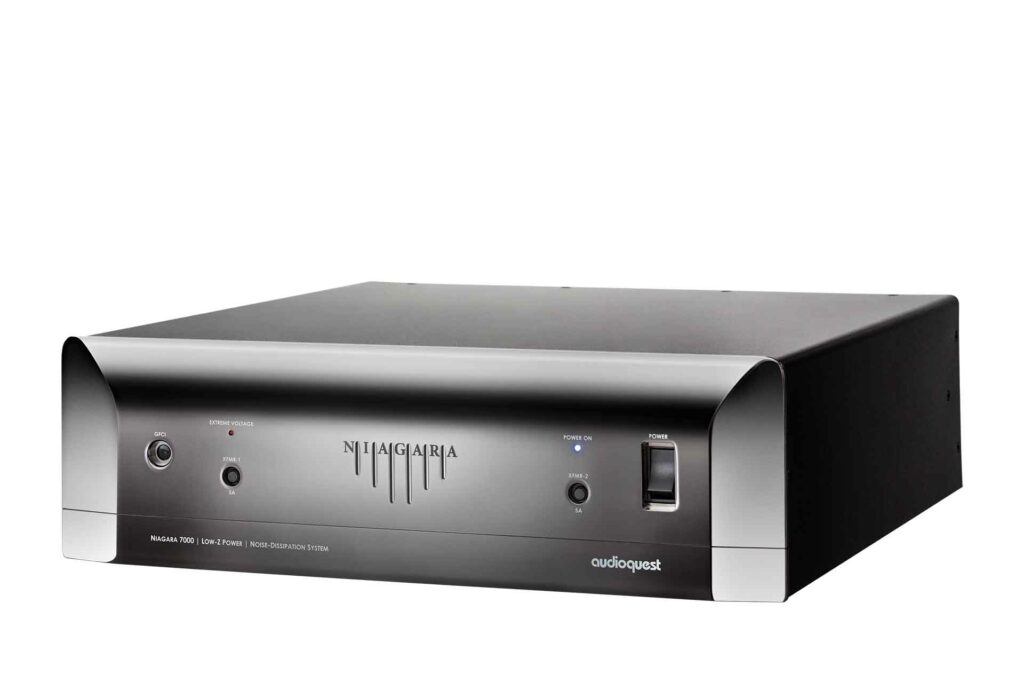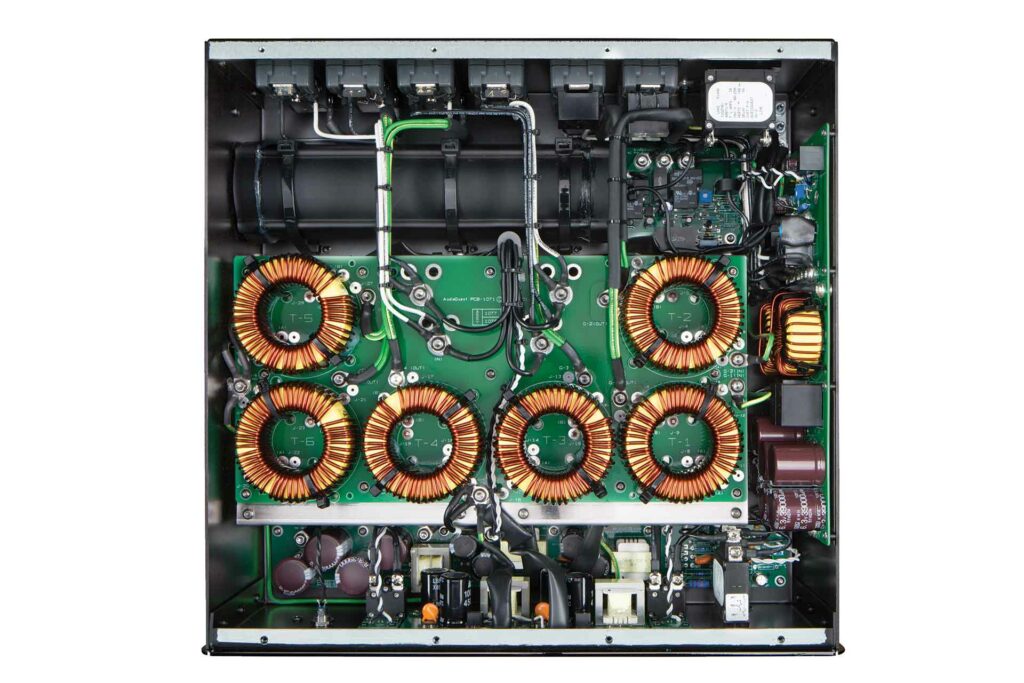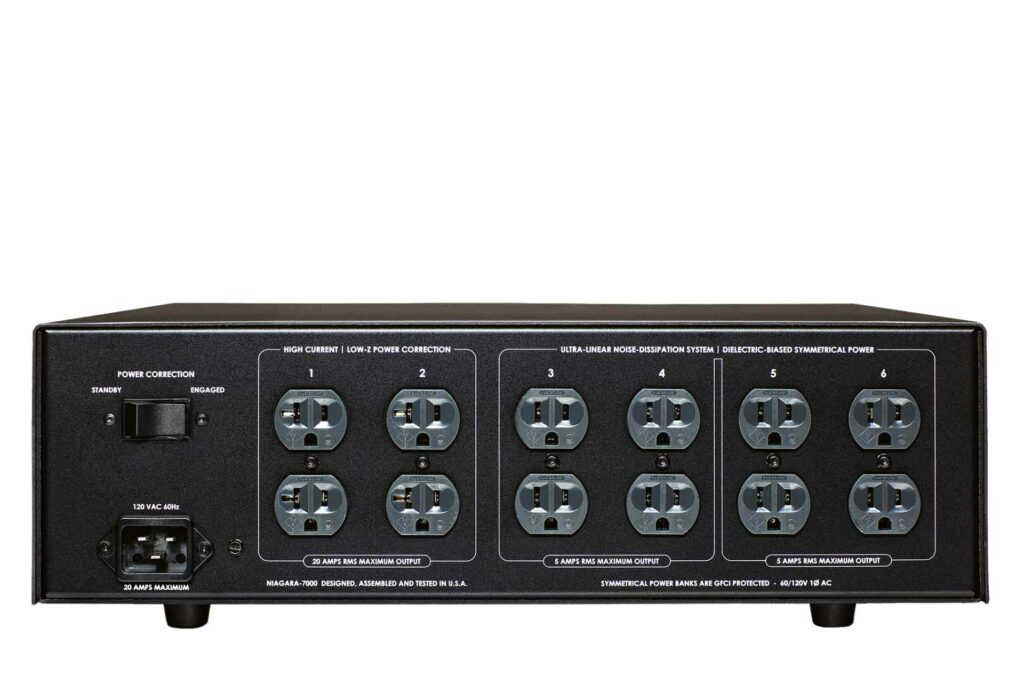When AudioQuest decided to expand beyond cables, power products were a natural choice. The company hired drummer, percussionist, and noted electronics and AC power expert Garth Powell to create an innovative power conditioner for the audiophile market. After considerable investment and almost two years of development, Powell and AudioQuest introduced the Niagara Series of power products. Officially, the Niagara 7000 is termed a “Low-Z Power Noise-Dissipation System,” but we will call it an audiophile-grade power conditioner to use more mainstream terms.
The company maintains that the AudioQuest Niagara 7000 (buy at Crutchfield) is more than a conventional power conditioner. Rather, it is a device aimed at reducing distortion without diminishing current to any device, including and particularly amplifiers. A feature that AudioQuest calls “Transient Power Correction” claims to provide a reservoir of 90 amps (peak) so amplifiers need not exclusively depend on power from the wall. A starved power amp isn’t going to perform at its best, and we all know there is less-than-perfect power in many parts of this fine country at all times of the day.
The Niagara 7000 has a symmetrical power dielectric-bias isolation transformers that are strictly for the source components. The TPC circuit utilizes an optimally damped reactance parallel circuit (akin to RMS power correction circuits) for the other inputs.

What Makes the Niagara 7000 Special?
The AudioQuest Niagara 7000 is not like a traditional power conditioner, as it addresses a variety of factors affecting AC line noise, distortion, and grounding. It provides a bank of current for amplifiers and even guards against voltage surges, such as a lightning strike. Garth Powell created a comprehensive system addressing four responsibilities: to reduce noise and distortion caused by components (symmetrical distortion), to reduce noise caused by external signals (common mode distortion), to reduce ground-induced noise, and to provide over-voltage protection. The Niagara 7000 has three separate banks of outlets designed for different types of audiophile components. The first bank is for amplifiers and powered subwoofers. The other two banks are for digital and analog components.

Why Should You Care About the Niagara 7000?
- Two transformers, using patented “Dielectric-Based Symmetrical Power Isolation Transformers,” provide a physical separation between high-current components like amplifiers and lower-current components like a DAC, preamp, or audio player.
- AudioQuest claims that the Niagara 7000 is designed to reduce distortion and improve sonic performance across the widest bandwidth in the industry. Using a proprietary technology called “Level-X Ultra-Linear Noise-Dissipation,” more than 23 octaves of differential-mode filtering and 20 octaves of common-mode filtering optimized for line and load impedance are claimed to address system-borne distortion, as well as airborne signals that become distortion. According to the company, this is important because, if one octave is filtered and the one a quarter octave away is not, the sonics are still compromised.
- A patented Ground Noise Dissipation Circuit dispels leftover ground noise, further reducing distortion and lowering the noise floor on musical reproduction. AudioQuest claims about one third of distortion is caused by ineffective grounds, and many power purification systems fail to address ground-borne distortion.
- Voltage-spike and over-current protection are highly welcomed features. The Niagara 7000 has the ability to detect 140 volts and up, and automatically shut off. Once the voltage has returned to normal, the unit will automatically power up. If, like me, you live in an area prone to violent, late-afternoon thunderstorms in the summer (complete with the lightning that typically accompanies them), this will be a reassuring feature. There are also circuit breakers that protect the individual banks of outlets. If these breakers detect too much amperage on any one of the three outlet banks, a breaker will trip. Once the problem has been corrected, the breaker may then be reset for normal operation.
- Unlike many lesser power conditioners from a decade (or more) ago, the 7000 is not sacrificial and simply destroyed with a big power surge. Let’s put it this way: If you lose your Niagara from some type of power surge, you likely lost a lot more in your house than just your audio system.
- Because system sizes and components vary, the AudioQuest Niagara 7000 has 12 AC receptacles. Several competing brands only offer room for eight components. For my system, I am currently using 10 of the 12 outlets. But the Niagara 7000 is only one in a family of power products all aimed at improved sonic performance. If you have a more modest-sized system, you can choose from three other Niagara units that cost less.
- The receptacles are physically tight, and inserting a male plug actually takes considerable effort. This is by design to ensure a substantial grip on the plug. The user manual even suggests how to go about inserting a male plug.

Some Things You Might Not Like About the Niagara 7000
- The Niagara 7000 is very heavy and possibly difficult to manage. Anyone uncomfortable with dead lifting almost 100 pounds should plan to have help to get this unit in place. In fact, AudioQuest recommends two people set it up—and I agree. Don’t throw your back out over an audio component.
- Because an entire audiophile system is plugged into the 7000, getting a dedicated home AC circuit is not a bad idea. Plugging the Niagara into a standard wall outlet may possibly cause a breaker to trip, depending on what else in the room shares that circuit—not to mention the power requirements of the system itself. While a mostly rare occurrence, circuit load is something that should be considered prior to purchase and isn’t too expensive to have upgraded in your home.
- There is no AC cable shipped with the 7000 to power the unit. AudioQuest maintains that this allows the user to provide the power cord of their choice and the length their system requires. It is also worth mentioning that AudioQuest manufacturers and sells nicely crafted, after-market power cords that are designed to work with the Niagara. AudioQuest claims that when using their cables that “noise is drained away” and that with their power cords in play that they Noise Dissipation circuit is complete. Their words. You can pick whatever power chord you like for the system at whatever level of budget that you feel comfortable investing in.
- The AudioQuest Niagara 7000 only comes in black. Yeah, I know that’s nitpicking, but in my system the 7000 is the only rack-mounted component that is not silver in color. For most buyers, this is hardly a sticking point, but I wish there was a silver finish even at a slightly higher price.
Listening To The AudioQuest Niagara 7000…
After connecting my entire system to the Niagara 7000 and allowing about three hours to warm up my components, I noticed improved clarity: Instruments sounded more distinct, and many sounded more natural. Dynamics were also recognizably louder. In fact, the whole musical presentation sounded like there was a slight increase in amplitude. Transients were more easily heard and had improved dynamics. I kept thinking, as I played music I knew quite well, “This sounds so much better!” Lastly, many songs had improved imaging.
Like many people, I’ve heard Pink Floyd’s “Money” (44.1/16 CD quality)
From Dark Side of The Moon track many times. With the Niagara 7000, I heard it differently than before. In the opening, the cash register and coins had a more intense presence due to increased dynamics, and the clarity here was also improved. This song has complex imaging: Through the Niagara 7000, sounds popped in and out, from side to side and front to back, in a way I hadn’t really noticed before. There was also an improved measure of transient attack that I haven’t heard previously—this tends to support the conclusion that the noise floor is improved. As I increased the amplitude, I did not get the feeling that distortion was also increasing. There was no fatigue as I passed 95 dB. The presentation just got louder without increased congestion. All in all, I could not have enjoyed this song any more.
Tommy, Pete Townshend’s landmark rock opera, has had a remarkable life. It and Quadrophenia are my favorite two works by The Who. There is so much to appreciate on “Pinball Wizard” (96/24 download). Who can deny the first 30 seconds is one of the most iconic rock-and-roll intros ever? Played through the Niagara 7000, Townshend’s guitar imaged on the far right of my room, while John Entwistle’s bass imaged to the far left. Both had especially ferocious dynamics. The clarity I heard with the 7000 in my system was incredible, and instruments all imaged in their own specific point in space in my audio room—more so than with the unit out of the loop.
Does the Niagara 7000 Have Any Resale Value?
AudioQuest has positioned itself as one of the more recognizable brands in this category. Because power devices are always being used in the audiophile community, the Niagara 7000’s resale value should be quite respectable, with all factors considered. Shipping weight and logistics would make resale a bit of a pain, but the unit likely will hold a good portion of its value for years to come.

Who Is the Competition for the Niagara 7000?
Holding an equal value proposition and widespread appeal among audiophiles is the Shunyata Everest 8000. At a cost of $9,900, it is slightly more expensive than the Niagara 7000. Both of these units serve to accomplish the same goals: the reduction of AC line distortion and the subsequent improvement of an audio system’s sonics. Both address current demands, voltage spikes, grounding, and cleaning the AC signal—in fact, what they claim to accomplish is quite similar. Both are market leaders in the category. Which one is better is a personal choice.
Power regeneration is another method to clean AC power. PS Audio is one company that manufactures these types of products. Power regenerators are a lot like power amps. They take in unfiltered AC power from the wall and (according to the manufacturers) convert it to a clean AC output for an audiophile system to use. Depending on the size of the system being connected, a power regenerator may be large and quite heavy, and it may produce a lot of heat. Theoretically, these devices should work exceptionally well, though actual performance may vary. It is vitally important that they are sized correctly. Having a regenerator that’s too small for a system may result in sonics that resemble an amplifier being driven to clipping.
Last up in the pantheon of audiophile power products are battery-powered regenerators. Most notable in this category is the German manufacturer Stromtank, which is marketed by the D’Agostino folks—so you know that it looks cool. This technology completely removes the audio system from the electrical power grid. AC power feeds the device in order to charge the batteries, but the audio system is essentially fed with 100 percent battery power. However, audio systems are not powered by DC current from a battery; they need an input of AC power. So all battery regenerators require an inverter to convert DC back to AC so the system can operate. Physical size, weight, and heat are the primary concerns with this category of product. To power my entire system, I would need a very large unit that would potentially produce significant amounts of heat. I would also need to hire a moving company to get it upstairs into my audio room. Batteries are, after all, very heavy. Once I got it to my room, the question of where to place it would be a very real concern, as would the length and cost of cabling to connect everything. The Niagara 7000, while heavy, easily fits into my audio rack—which makes connecting my components very convenient and cost effective.
All of these technologies have both advocates and detractors. It is largely a matter of personal preference and how well, or how poorly, any one of these technologies will work for an individual user. I see the bigger question being whether or not an audiophile will choose to use any type of power purification product. Or conversely, will they simply plug their audio system into a standard wall outlet with little concern for the quality of AC power.
Final Thoughts on the AudioQuest Niagara 7000
I’ve believed in the benefit of power management for years, so for me, installing the Niagara 7000 in my system was an easy decision. It has exceptional build quality. In fact, everything inside the unit is broken in before assembly, so once it arrives at your home, it won’t need an extended break-in period.
With the The AudioQuest Niagara 7000 in my system, I heard much better clarity and detail. Instruments often sounded more lifelike, particularly those in the midrange frequencies. Vocals sounded less mechanical. I was able to reduce the volume level on my preamp by one or two clicks, depending on the recording, and maintain equal amplitude. Imaging was also more accurate, and I got a wider sonic presentation overall.
Anyone in the market for a power purification system should audition the Niagara 7000—or at least audition one of the other three lower-priced Niagara models. What the 7000 did for me was one of the more transformational improvements I have ever made in my audio journey. Basically, it made listening to music easier, more organic, and more natural. I cannot recommend it any more emphatically. And because I still have two empty outlets, I have room for two more components. As such, the 7000 isn’t going anywhere anytime soon.
In the world of power management, AudioQuest is a market leader, and the Niagara 7000 is a proven product that absolutely delivers what it claims to deliver. It will protect your audio system and make it sound better. Period. What more can you ask of any power-conditioning product?



